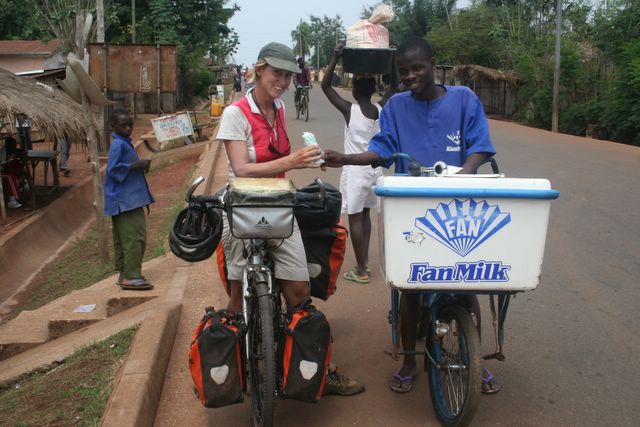update 11.
cool mountain air and voodoo
Togo and Benin
5 - 17 February, 2007
Total kilometers cycled: 17,625
Specific country info on routes & roads/food & accommodation/the locals available here.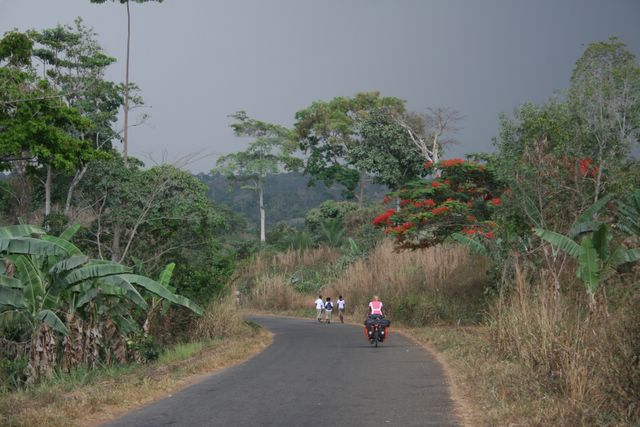 From Accra we might easily have continued along the busy coastal road,
quickly passing through tiny Togo and Benin on our way to Nigeria.
We were lured inland by the thought of cooling off in Togo's
picturesque plateau region and exploring voodoo shrines in
Benin. We were in for some leg-breaking climbs and spectacular
scenery and even more spectacular storms as the dry season comes to an
end and the first rains wash away the layer of dust that has settled
over the land.
From Accra we might easily have continued along the busy coastal road,
quickly passing through tiny Togo and Benin on our way to Nigeria.
We were lured inland by the thought of cooling off in Togo's
picturesque plateau region and exploring voodoo shrines in
Benin. We were in for some leg-breaking climbs and spectacular
scenery and even more spectacular storms as the dry season comes to an
end and the first rains wash away the layer of dust that has settled
over the land.First stop over the border was Badou, a small town in the heart of the coffee and cocoa growing region and a good base for a visit to Togo's most impressive waterfalls, Akloa Falls. We paid the required fee and took the obligatory guide, which turned out to be a good thing as the vegetation was dense and we weren't keen on taking a wrong turn, getting lost and spending the night among the monkeys and mosquitoes of the forest. The climb was steep and strenuous in parts, and it was a real blow to the ego to be passed up by old women and children balancing large loads of wood and plantains on their heads as they practically ran up the slopes of the mountain. We were duly impressed by the waterfalls but the sky was quickly clouding over and it threatened to rain so we forwent a dip in the pool below the cascade.
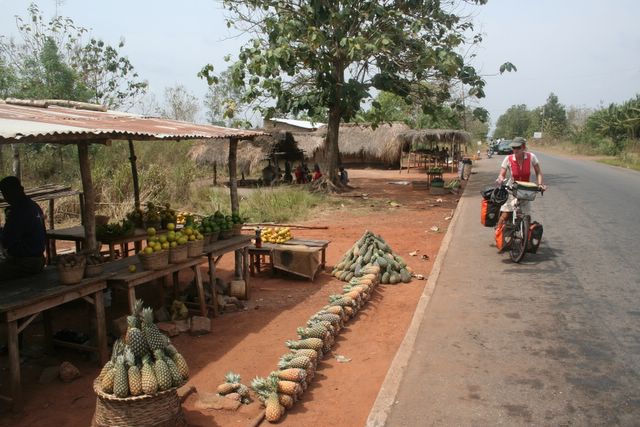 We
continued through rural Togo, passing sheer cliffs and quaint villages
all the while enjoying the relatively cool air that came with the climb
in altitude. Our last stop before heading back towards the coast
was Kpalimé, a favorite getaway of the Germans when they were
the colonial masters of Togoland before World War I. Early one
morning we cycled up the pretty road carved out by the Germans that
snakes it way through the forest and up to Mount Klouto and
enjoyed the view over the cocoa country and into Ghana. Then we
ventured a look at the Chateau Viale where we were asked for our
official authorization to visit. Not having the said document
(surely no such thing exists) the caretaker assured us that he could
perhaps bend the rules in exchange for a small gift. Yes,
everything is possible here in Africa...for a price.
We
continued through rural Togo, passing sheer cliffs and quaint villages
all the while enjoying the relatively cool air that came with the climb
in altitude. Our last stop before heading back towards the coast
was Kpalimé, a favorite getaway of the Germans when they were
the colonial masters of Togoland before World War I. Early one
morning we cycled up the pretty road carved out by the Germans that
snakes it way through the forest and up to Mount Klouto and
enjoyed the view over the cocoa country and into Ghana. Then we
ventured a look at the Chateau Viale where we were asked for our
official authorization to visit. Not having the said document
(surely no such thing exists) the caretaker assured us that he could
perhaps bend the rules in exchange for a small gift. Yes,
everything is possible here in Africa...for a price.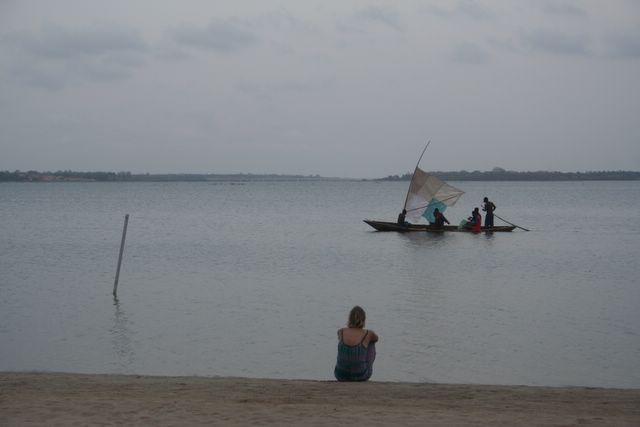 Lomé, Togo's capital, is a fairly low-key place and we took a room at Le Gallion,
a Swiss-run auberge just 50 meters from the beach--which we didn't
visit, incidentally, since it's too hot during the day and too
dangerous at night. Instead, we relaxed on the shady balcony
outside our room and watched the comings and goings of the expat
community, for which the attached restaurant was obviously a favorite
haunt. Lots of balding European men in oversized 4WDs pulling up
with sexy young African women. You draw your own conclusions.
Lomé, Togo's capital, is a fairly low-key place and we took a room at Le Gallion,
a Swiss-run auberge just 50 meters from the beach--which we didn't
visit, incidentally, since it's too hot during the day and too
dangerous at night. Instead, we relaxed on the shady balcony
outside our room and watched the comings and goings of the expat
community, for which the attached restaurant was obviously a favorite
haunt. Lots of balding European men in oversized 4WDs pulling up
with sexy young African women. You draw your own conclusions.We would soon be leaving the West African Franc (CFA) currency zone and needed to get our hands on Nigerian Naira and some Central African francs used in Cameroon as well as stock up on dollars for Congo, where the greenback is king. Bank bureaucracy is tiresome and their exchange rates are poor, so we headed to central Lomé with its thriving black market to conduct a little business. Finding the right spot wasn't difficult, because there were several men on the aptly name Rue du Commerce waving wads of currency and shouting 'change money, change money'. We put in our order for the various different currencies and within a few minutes our contact man was back with the money. After carefully counting the bills, we paid up and the deal was concluded. A very efficient and time-saving process.
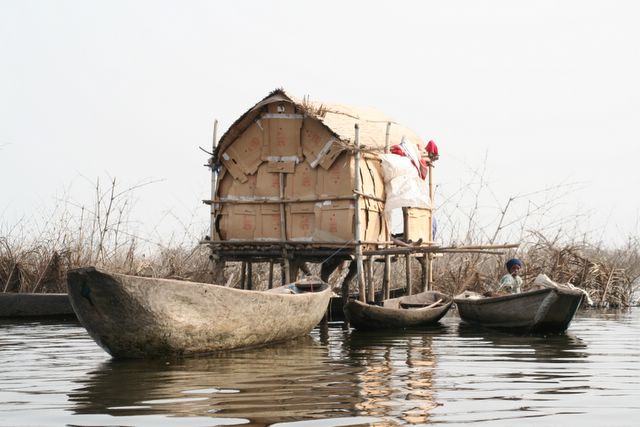
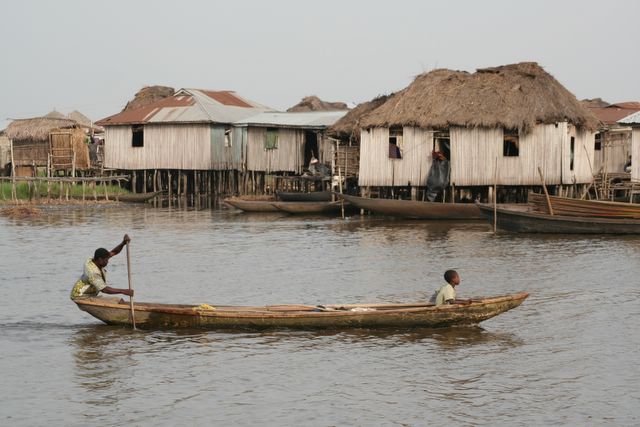 Palm-fringed
beaches and inland lagoons line the coastal highway into Benin, but the
ride was marred by the hectic traffic between the two capital cities.
We steered clear of congested Cotonou and made our way instead to
Benin's biggest tourist draw, the stilt village of Ganvié.
Here we hooked up with three motorcyclists who were also
following the West Africa overland route and swapped travel stories and
tips. And together we did the obligatory visit of the village in
a wooden pirogue, a boat obviously being the only way to visit a town built on a lake. It was
a bit of a tourist-trap, but nevertheless a fascinating place.
Some 18,000 people are said to live in the thatch huts teetering
on stilts over the shallow (and mighty polluted it appears) waters.
Transport is strictly by canoe
Palm-fringed
beaches and inland lagoons line the coastal highway into Benin, but the
ride was marred by the hectic traffic between the two capital cities.
We steered clear of congested Cotonou and made our way instead to
Benin's biggest tourist draw, the stilt village of Ganvié.
Here we hooked up with three motorcyclists who were also
following the West Africa overland route and swapped travel stories and
tips. And together we did the obligatory visit of the village in
a wooden pirogue, a boat obviously being the only way to visit a town built on a lake. It was
a bit of a tourist-trap, but nevertheless a fascinating place.
Some 18,000 people are said to live in the thatch huts teetering
on stilts over the shallow (and mighty polluted it appears) waters.
Transport is strictly by canoe 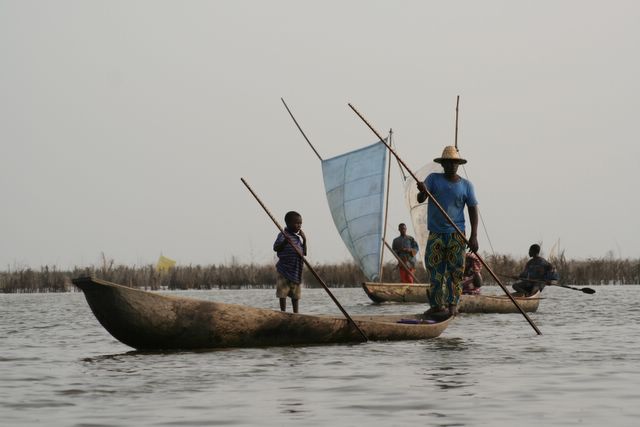 and it seems even toddlers can maneouver a boat. We were passed by plenty of fishermen and women hawking their wares
over the side of wooden vessels as they paddled through the marshy
waters, and despite the touristy nature of the excursion there was a
sort of magical quality to the place.
and it seems even toddlers can maneouver a boat. We were passed by plenty of fishermen and women hawking their wares
over the side of wooden vessels as they paddled through the marshy
waters, and despite the touristy nature of the excursion there was a
sort of magical quality to the place.Benin is known as the cradle of voudou (vaudou or vodoun in some dialects), an ancient African set of beliefs centered around spirits and intermediaries possessing supernatural poweres as well as fetishes, charms and temples. We wandered around the voodoo strongholds of Ouidah and Abomey and tried to imbibe some of the eerie atmosphere. Unfortunately, most of the the temples are off-limits to outsiders and picture-taking is frowned upon unless you cough up a small tip for the pleasure of snapping. This kind of an attitude, as well as the constant request for gifts, took some of the charm out of our tour of Benin.
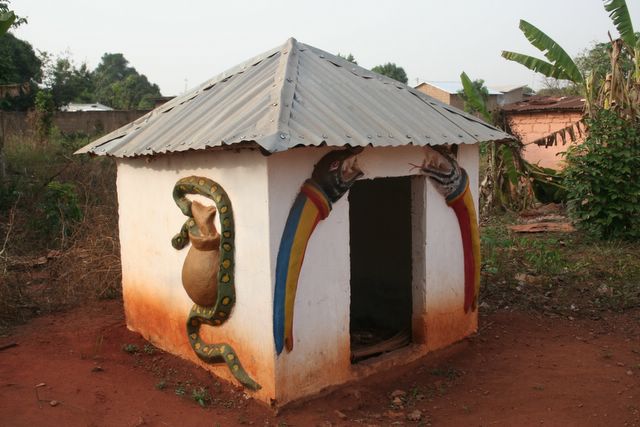
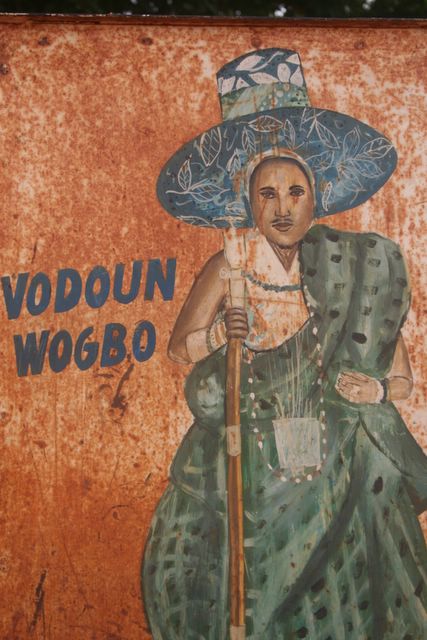 Temperatures
rose, the sun intensified and the tropical vegetation gave way once
again to savanna as we continued further north to Save and the border
crossing into Nigeria. Our Michelin map showed just one direct
route into the country, so when the road forked we motioned towards the
well-used track on the right and asked if that was the way to Nigeria.
The response was affirmative so we rode on confident in reaching
the border post, where we intended to spend the night, just 20
kilometers further on, according to the map.
Temperatures
rose, the sun intensified and the tropical vegetation gave way once
again to savanna as we continued further north to Save and the border
crossing into Nigeria. Our Michelin map showed just one direct
route into the country, so when the road forked we motioned towards the
well-used track on the right and asked if that was the way to Nigeria.
The response was affirmative so we rode on confident in reaching
the border post, where we intended to spend the night, just 20
kilometers further on, according to the map. We rode and rode and still there was no border post in sight. Finally a vehicle passed and we flagged down the driver who told us it would be another 80 kilometers before we reached Nigeria! This was alarming as it was late afternoon and there were no settlements in sight. After a protracted discussion with
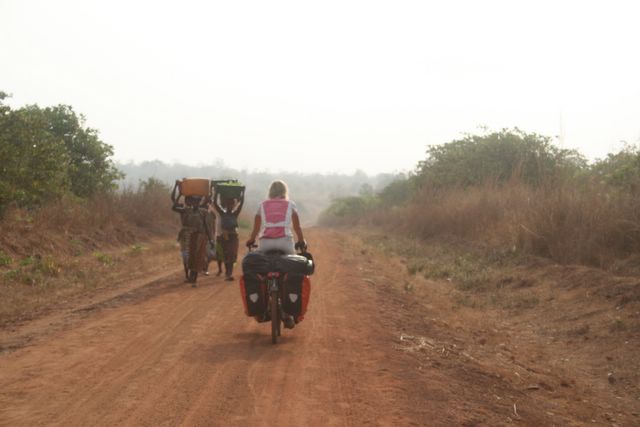 the driver, we realized there were two routes into Nigeria and that we
should have taken the fork on the left. Not fancying a night in
the bush, we turned around and had just enough time to make it back to
Save before sunset.
the driver, we realized there were two routes into Nigeria and that we
should have taken the fork on the left. Not fancying a night in
the bush, we turned around and had just enough time to make it back to
Save before sunset.There's a lot packed into these two tiny countries and it was well worth taking the time to explore them. Tourism is fairly well-developed so travel was relatively easy and we could rest up before facing the rigours of non-stop Nigeria. There was a dependable supply of water and electricity, tasty rice and beans, loads of fresh fruit and the ubiquitous FAN MAN, serving up delicious frozen yoghurt and ice cream. What more could a person want?
